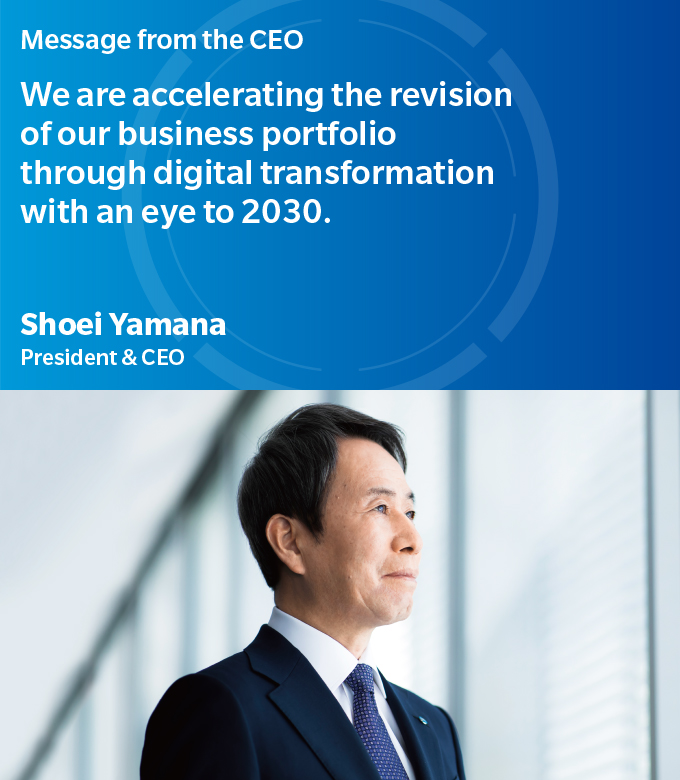Response to the COVID-19 pandemic We are bringing together the collective strength of the Group to overcome this unprecedented crisis
I first would like to express my deepest condolences to the people around the world who have lost friends and family due to the COVID-19 pandemic and pray for a quick recovery for people who have contracted the virus. I would also like to express my deepest respect to the government and local officials working on the front lines to prevent the spread of the disease and to the healthcare professionals at medical facilities who are working day and night to diagnose and treat patients with the virus.
As the virus spreads worldwide, the Konica Minolta Group’s top priority is protecting the health and safety of its employees and their families while doing everything in its power to support its many customers that have mobilized to fight the disease. We donated ultrasonic diagnostic devices to hospitals, and Group employees assisted various sites by providing non-contact, instant-display medical thermometer systems. I am especially gratified that these actions taken by our Group employees were instigated by a bottom-up approach. I think the sincere desire that many of our employees have to improve the world and be useful to society is a reflection of the positive DNA that Konica Minolta has inherited as a company.
We are prepared to continue our business activities while coexisting with COVID-19 for at least the next few years. In the era of the new normal, our desire to play a role in people’s work and daily lives will continue, and I want our employees to work together to speed up our business transformation and overcome the difficult times.
Looking back at the SHINKA 2019 medium-term business plan In very challenging market conditions, we ultimately fell far short of our management targets.
Since taking the position of CEO in 2014, I have been consistently pursuing “customer value” and have sought to change from a company providing excellent products to a “company providing value by solving issues.” During the TRANSFORM 2016 and SHINKA 2019 medium-term business plans, the Group sought to leverage its intangible asset of “connections with two million customers worldwide” and to deepen our connections with customers and build strong relationships of trust by providing “value” that helps them improve business efficiency and increase revenue.
To achieve that, we shifted our product-driven operations in each business unit to service-driven businesses utilizing our imaging and data technologies. At the same time, we promoted the formulation of recurring profit businesses that do not require initial investment by customers and that are easy for small and medium-sized enterprise customers to introduce. Our efforts to transform our business model have progressed generally as planned over the past six years.
The performance results through fiscal 2018 continued strong although somewhat behind our plan, and in fiscal 2019, the final year of SHINKA 2019, our results came in short of our targets with consolidated revenue of ¥996.1 billion and operating profit of ¥8.2 billion. As the head of the corporation, the shortfall is my responsibility and I view these results with the utmost seriousness. Below, I explain some of the reasons for our underperformance by dividing them into two general factors: the external environment and our business activities.
SHINKA 2019 targets for Core, Growth, and New Business operating profit
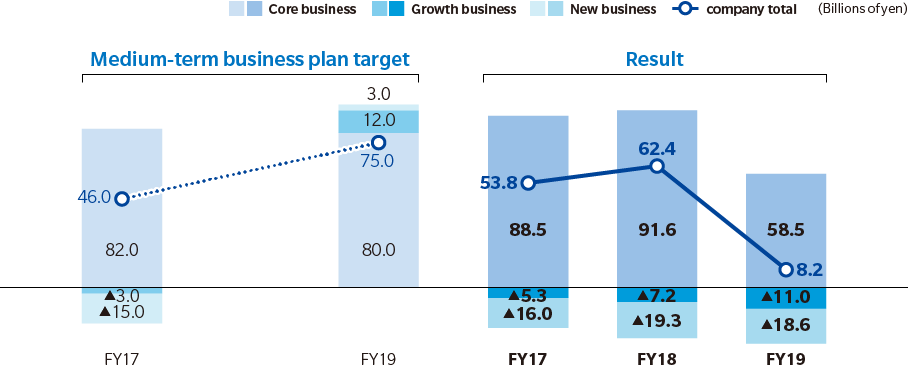
Factor 1: The changing external environment
In the past three years, digitalization and the expanding use of AI has triggered rapid changes at business sites in all types of industries and businesses. The dynamics of the global printing industry have also changed dramatically. While the digital printing market has expanded in China, India, the ASEAN, and other countries experiencing economic growth, the growth in print volume has slowed in Europe, the United States, and other developed countries where digital technology is engendering new work styles and the digitalization of administrative processes. We had anticipated these market trends and took various steps to prepare our businesses, which I will outline below.
In addition, when we were creating the SHINKA 2019 plan in fiscal 2017, we also anticipated an increasingly challenging economic environment. However, the economic environment deteriorated even more than we anticipated beginning in the second half of fiscal 2018 with the intensifying trade friction between the United States and China, slowing economic growth in China, a sluggish European economy, and a receding appetite for capital investment worldwide. All of these developments had negative impacts on our business segments. Then the additional tariffs on Chinese goods that came out of the U.S.-China trade dispute caused drops in profits for our core Office and Professional Print businesses, both of which have production operations in China.
Finally, we confronted the unexpected outbreak of the global COVID-19 pandemic at the end of fiscal 2019. The pandemic severely restricted our businesses and our sales activities to customers as well as installation of previously ordered products. The lockdowns in Europe and the United States begun in March 2020 had particularly strong impacts on revenue and profits in the Office, Professional Print, and Healthcare businesses, all of which usually are in peak demand during this period.
Factor 2: Weakened core business profitability
and delayed revenue contribution from new businesses
Our inability to sufficiently increase the earning power of the Office Business, which accounts for about 55% of companywide revenue, had a major impact on our overall profits. One of the main factors behind this was the time it took to resolve problems associated with the design robustness of our new multi-functional peripheral (MFP) equipment, for which we were planning to begin mass production after the first full model change in seven years at the Malaysia factory. Our efforts to guarantee quality and prioritize supply led to higher costs while holding down production yields, with the result of lower-than-expected profits from the new models.
In the Professional Print Business, the production print market did not grow as much as we forecast although we maintained the top share in the commercial printing market, which is a main focus. While the market has expanded in growth countries in the past three years, the digitalization of commercial printing did not develop as much as we were anticipating in developed countries.
In the New Businesses, expansion of the Workplace Hub service platform, which is designed to leverage our Office Business customer base, did not grow as rapidly as we had planned. Although a certain number of our main target of small and medium-sized enterprises recognized the value of Workplace Hub, it took us longer than expected to develop the basic software to consistently deliver value while expanding the number of customers, and it was not until February 2020 that we were able to upgrade the product to its final form. The delay to our plan was the main reason we did not reach our target.
In the bio-healthcare business, we launched operations centered on the United States following the two major acquisitions of Ambry Genetics and Invicro in fiscal 2017. Both companies have the high-level technical capabilities that we expected; however, the bio-healthcare business did not expand as quickly as we were planning due to issues that became apparent with their abilities in marketing and in negotiating with insurance companies and because of the time needed to strengthen the business foundation, such as by bringing in management-level human resources.
In the past three years, we have laid the groundwork for the next growth in our core business.
I want to emphasize that, while the external environment unexpectedly changed and some projects did not progress as planned, in the last three years we still made significant progress and achieved several positive results.
First, the Office Business has resolved all the issues related to the mass production of the new model MFPs in Malaysia. Production unit prices are now equal to below the production prices in China. My sense is that our competitiveness is being boosted by the new A3 color MFPs, which features the industry’s highest level of security functions. Also, in fiscal 2019 we introduced models in each of the low-, mid-, and highspeed ranges, which puts us in position to promote a full lineup of offerings in fiscal 2020.
The production print business unit introduced its first heavy production printer (HPP) while maintaining its top position in the mid-production printer (MPP) and light production printer (LPP) segments in fiscal 2019. Aimed at meeting the demand for large-volume printing, we believe the new HPP will become a major product of the production print business.
The Industrial Business fortified its competitive advantage in the performance materials fields by successfully shifting to high value-added products in anticipation of larger display screens and technological changes. The business was also authorized by production partners for new resin films in the second half of the fiscal year, thereby increasing its ability to meet customer needs and opening new possibilities to offer even higher value-added. In the measuring instruments business unit, the business strengthened its business foundation in color measurement technologies supported by the increasing sales of mobile products and by diversifying its customer base and advancing the commercialization of its products in the growth field of visual inspection equipment.
We are accelerating our business portfolio transformation
in accord with the decreasing volume of in-office printing.
We recognize that we have not yet developed businesses capable of generating large revenue streams in our new and growth businesses. Nevertheless, I am confident that the fundamental direction we are taking to transform our business portfolio for declining demand in office printing is the right decision. The COVID-19 pandemic has significantly changed office employee workstyles and workplaces, and I have to think that this will hasten the peak out in office print demand. This makes it all the more clear to us that in order to survive as a company, we need to speed up the creation of a business structure that is not reliant on profits from office printing.
We also produced achievements in the nonfinancial areas of the environment and human resources.
In addition to our business performance, we also realized several significant non-financial achievements during the three years of SHINKA 2019. Our environmental measures made significant progress. Amid growing worldwide awareness of the risks from climate change, we broadened the circle of support for our “Carbon Minus” activities from our client companies and suppliers to firms in other industries by creating a digital environmental platform for sharing environmental expertise among industries throughout Japan.
Another positive result of the last three years is how we have strengthened our human capital (personnel), which is a critical intangible asset. A diverse workforce is essential to creating new value. The Konica Minolta Group is actively hiring women and non-Japanese while also shifting to a workforce that will strengthen our understanding of our customers’ businesses. Our aggressive M&A activities have also brought in many outstanding personnel. We made a particularly substantial advance establishing a foundation of personnel in the Imaging IoT field, which is a key to future digital transformation (DX), by adding some 500 Imaging IoT professionals in Japan and overseas.
Long-term management vision for 2030 We reexamined our purpose and formulated a new long-term management vision.
We have announced our long-term management vision for 2030. The purpose of creating the vision was to provide a clear image of what we want the Company to be in 10 years, well beyond the end of the pandemic, and then to backcast to determine what we need to do now as a group to fulfill the vision. To form the vision, we held deep discussions on the question “What will be the Company’s reason for existence 10 years from now?”
Since our founding, Konica Minolta has responded to the needs of customers around the world using our core image input and output technology and imaging technology, centered on image processing, cultivated in its camera and photograph businesses. I consider our imaging technology as the origin of our DNA. By further developing that DNA and fulfilling people’s desire to “see” various things, we can enhance the productivity and creativity of professionals working at client companies, and through that we can seek to provide engagement and well-being to the people who are the ultimate end users and can also contribute to realizing a sustainable society. Our discussions therefore uncovered two higher purposes for our company—to support people to achieve their purpose in life and to create a sustainable society.
These ideas are encompassed in our management vision statement, “Imaging to the People.” The statement directly expresses that the reason for our existence is to continue our DNA of fulfilling our customers’ desire to “see” and realize both people-centered engagement with worksite professionals and the creation of a sustainable society.
Konica Minolta’s social purpose
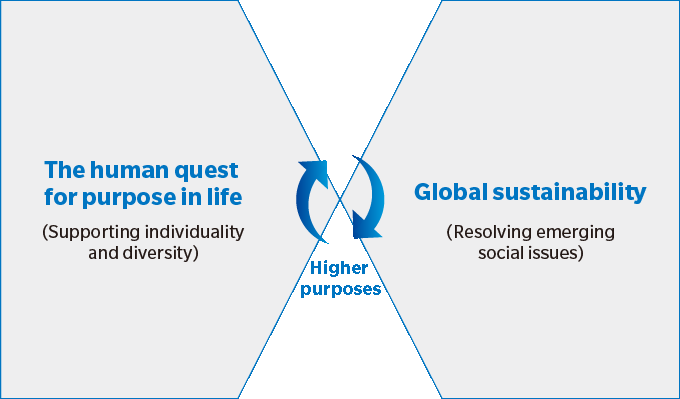
Management Vision (2030 Company Image)
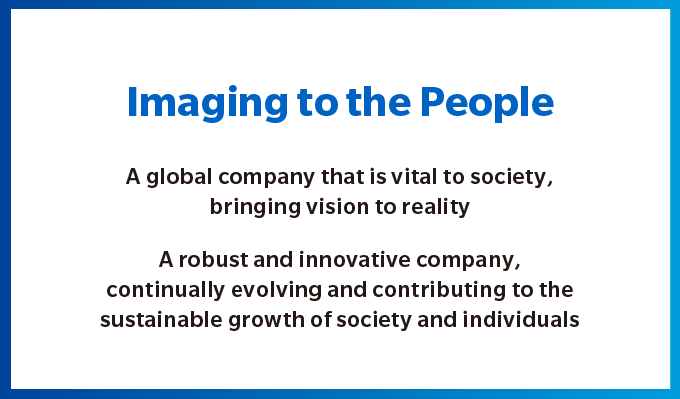
We clarified the Company’s social value for 10 years from now, which we adopted as our “material issues”
To enable us to realize our management vision for 2030, we need to also consider how the world will change and what social issues will arise in the years ahead. While setting the long-term management vision, we also imagined what social issues might be present in 10 years and clarified the social value we can provide as a company for addressing those issues. We call the social value we can provide our “five material issues”.
These material issues represent themes into which we can concentrate the Group’s intangible assets to generate significant social value. We created target images for the company in 2030 for each of the five material issues and set clear directions for creating value in the medium and long term.
We then backcast from the vision for 2030 and formulated three-year management strategies. For each of the five material issues, we plan to set specific KPIs for “environmental and social value” quantifying the impacts of addressing environmental and social issues and for “economic value” quantifying the contributions these activities make to profits. These material issues will be incorporated to the business plans of each business unit, and we will advance initiatives integrating business growth and sustainability.
The five material issues
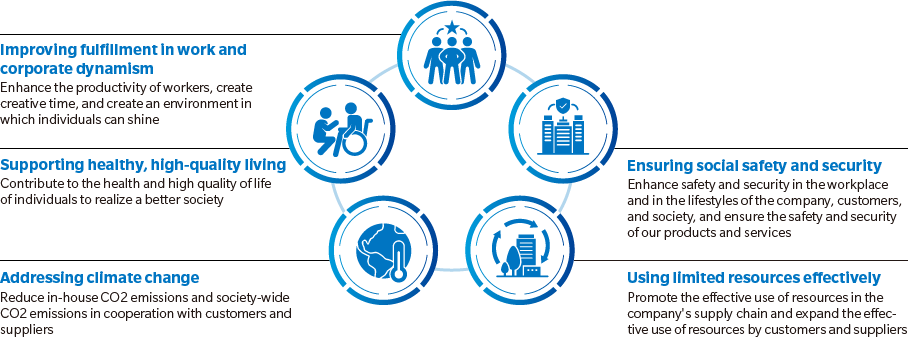
Realizing the management vision through a “BtoB-to-PforP” approach
Since becoming president of the Company, my view has been that sustainability and our management and business strategies are one and the same, and that contributing to realizing a sustainable society will lead to sustainable growth for the Company. Since its beginning, Konica Minolta operated under the belief that helping resolve social issues creates new value and is a foundation for growth, and that belief is held throughout the Group. One of Konica Minolta's greatest strengths is that each employee at each business site thinks about the meaning of the “6 Values” and can make their own decisions and implement them in their actions.
I describe the approach we are taking to fulfill our management vision as “BtoB-to-PforP” or business-to-business to professionals for people. This approach goes beyond the simple BtoB products and services. By supporting business transformation for professionals in manufacturing, medical and nursing care, and other industries, we can enrich the lives of the people who are the end users while at the same time boosting the engagement and job satisfaction of the people at the worksites. I want to create a society where many more people can be motivated and happy by using this BtoB-to- PforP approach to address social issues and by using our imaging technologies and enabling all of our employees to shine in all of our business domains.
The BtoB-to-PforP approach for realizing our long-term management vision
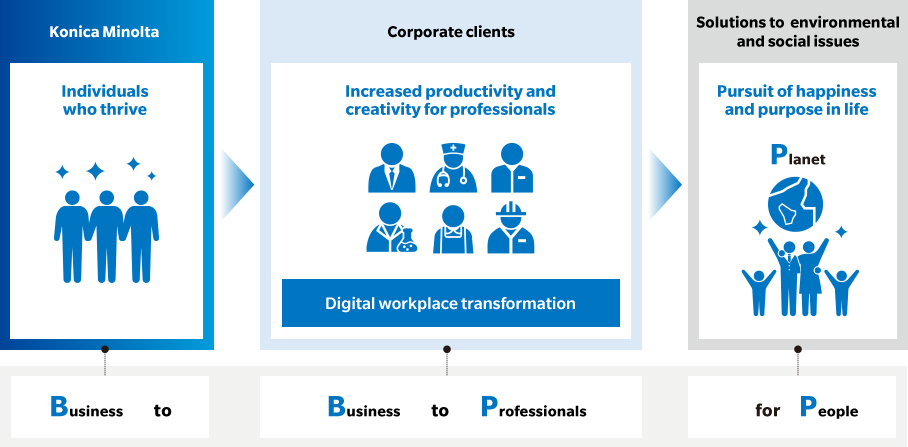
Medium-term Business Strategy DX2022 The groundwork set during the previous medium-term business plan will be diligently developed into results.
The medium-term business strategy "DX2022" will start in fiscal 2020. The biggest challenge during the three years of DX2022 will be to finish any remaining items from the previous SHINKA 2019 plan and to diligently develop the established groundwork into to results. DX2022 will also be a milestone (benchmark) for our progress toward realizing our management vision for what we want the Company to be. The next three years will also be a critical period for establishing exactly “what we need to do” as determined by backcasting from our long-term management vision.
The fundamental objectives of DX2022 are to “leap to highly profitable business through DX” and to “evolve into a company clearly committed to solving social issues.” The plan is also designed so we can further enhance the value for our customers through a recategorization of the three “core, growth, and new” business categories and a recasting of the strategies in each business segment.
The Office Business has been renamed the Digital Workplace Business and will provide DX support to clients through a combination of our MFPs, IT service solutions, and Workplace Hub. The business will support value creation at our customers by through our unique value creation for all types of business sites, including offices, hospitals, distribution centers, and production sites. The Professional Print Business will provide automation and labor-saving operations that can only be achieved using digital technologies while also supporting printing companies seeking to transform into value-added businesses.
The Healthcare Business will offer diagnostic imaging, including using X-ray imaging and ultrasound systems, along with medical IT services for diagnostic support. The business will also provide integrated support for genetic diagnostics and drug discovery support services to provide value for disease prevention, early detection, early diagnosis, and new drug development.
The Industrial Business, which was previously separate segments, will be combined as the Industry Business. The business will offer measuring instruments, materials and components; status monitoring solutions using imaging IoT technology; and value for the safety and security for various manufacturing operations.
Positioning of the DX2022 medium-term business strategy
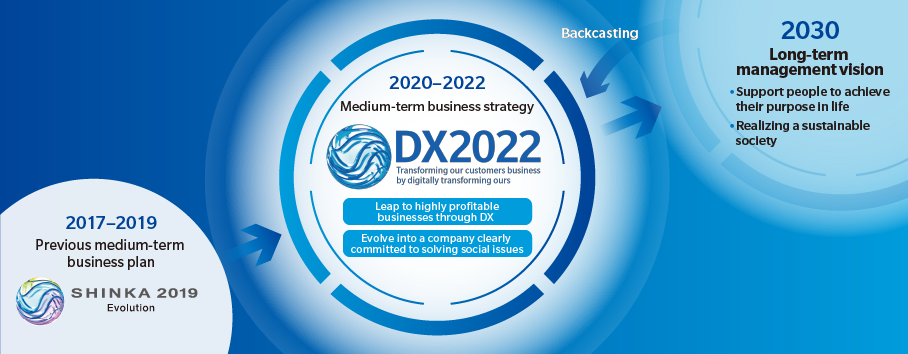
DX will enable us to advance our business model, build stable profit streams,
and boost our competitive advantages.
Our imaging IoT Platform (see page 27) is the foundation from which we will drive our business strategies. We will combine AI and IoT technologies with our strength in imaging technology to create high value-added, high-profit businesses utilizing continuous streams of images and other data from the application sites.
All of our products and devices are Smart Connected Products that connect to a network and allow the on-site workers to access various types of software that can be used to reform their operations and improve their workflow.
We will develop these businesses by continuing to take a medium-term perspective on acquiring and cultivating our imaging IoT personnel. During the three years of DX2022, we plan to increase our staff from the current 500 to 1,000 people. We have also established an R&D base in Canada and have begun joint research with a university on advanced AI technology. We also boosted our imaging IoT development capabilities in Japan in August 2020 with the construction of a new development center at the Takatsuki Site in Osaka Prefecture.
We are stepping up business selection and concentration, and strengthening sustainable areas.
To enable even more effective business portfolio management, we are continuing to select and concentrate our businesses following three criteria.
The first criterion is the business attractiveness. We are looking for businesses with future growth potential, with business scale to become a new pillar for the Company, and with profitability at a level that will enable future investments.
The second is the ability to continue strengthening the competitive advantage. Based on the strengths of our current intangible assets and businesses, we will organically incorporate capabilities we currently lack for digital transformation so we can provide value that is indispensable for our customers’ operations. By doing that, we will create strong customer relationships that will be impenetrable by competitors.
The third criterion is compatibility with our corporate strategy. We will focus on businesses capable of fulfilling the Konica Minolta objectives for environmental and social value. I would like to focus on business areas where we can make Konica Minolta the number one preferred business partner by professionals on the ground.
Our standard policy is to provide specific projection figures when we announce our medium-term strategies. However, the COVID-19 pandemic has made it virtually impossible to accurately predict the trends in the global economy and our business environment. Due to the circumstances, we have not set specific target figures for the DX2022 plan. We will announce figures when a forecast can be made with reasonable accuracy.
Thought on our transformation We will develop our strength in imaging technology to visualize a new future.
I have a strong sense that the Japanese manufacturing industry is at a crucial point in terms of its future. Underlying my awareness of the problem is a strong sense of crisis about the future of the Japanese manufacturing industry. It would be extremely perilous if Japanese manufacturers are operating as if the “Japan as No.1” success from over 30 years ago were still relevant today. Platform companies like GAFA (Google, Apple, Facebook, and Amazon) are dominating worldwide, and China and other countries are ascending at a tremendous speed using the very same model that Japan rode to success. Japanese manufacturers will be hard put to survive if new high value-added businesses arise that can become game changers.
Konica Minolta possesses advanced technology that the large global IT companies simply do not have, and our image processing and analysis technologies in the imaging field are especially competitive. I believe that the mission for our top management is to harness our outstanding technologies to create true value.
This value is the value for our customers, which is always “on site” at their operations, and “on site” means the value is for the people who work there. The only way to create true value for our customers is to provide the meaning and creativity for the people at the operating sites. I believe our success will come from the multitude of direct connections we have with the people “on site.”
Imaging technology that can “make the invisible visible” is essential for all types of human creativity and communication, and the need for that technology will never disappear. Konica Minolta has been dedicated to expanding the scope of human vision for nearly 150 years. If we continue to ask, what is our technology used for? who uses our technology? and how can our customers use our technology to create value? then it is certain that Konica Minolta will continue to grow and flourish.


